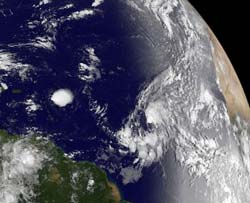2 satellites see Tropical Storm Ophelia born in the Atlantic

This image from NOAA's GOES-13 satellite was captured at 4:45 a.m. on Sept. 21, 2011, and shows Ophelia as a large and still disorganized area of clouds (right). Ophelia is about 350 miles in diameter. The smaller rounded area of clouds (left) is another low that has a zero percent chance of development. Credit: Credit: NASA/NOAA GOES Project<br>
NASA and NOAA satellites were watching the low pressure System 98L in the central Atlantic yesterday when it was 1450 miles east of the Leeward Islands.
Yesterday, Sept. 20, 2011 at 4:11 p.m. NASA's Aqua satellite flew over System 98L before it became a tropical storm. An infrared image from the Atmospheric Infrared Sounder instrument onboard showed System 98L's strongest thunderstorms and coldest cloud tops (colder than -63F/-52C) were banded north and south of the center of circulation. Those bands of thunderstorms were a sign that the low pressure area was organizing and strengthening.
While the U.S. was asleep, System 98L organized and strengthened further into Tropical Storm Ophelia. By the early morning of Sept. 21, her center was near 12.7 North latitude and 41.8 West longitude, about 1370 miles east of the Leeward Islands. Her minimum central pressure is 1005 millibars. Ophelia has maximum sustained winds near 45mph. Those tropical storm-force winds extend out to 175 miles making Ophelia a good-sized tropical storm, about 350 miles in diameter.
An image from NOAA's GOES-13 satellite was captured at 4:45 a.m. that shows Ophelia as a large and still disorganized area of clouds. The image was created by the NASA GOES Project at NASA's Goddard Space Flight Center in Greenbelt, Md. The image shows curved bands of thunderstorms mostly over the northern and southern quadrants of the storm. Infrared satellite data shows that there's not much convection (rapidly rising air that forms the thunderstorms that power a tropical cyclone) near the storm's center.
Ophelia is still too far away from land for watches or warnings. She's moving west at 14 mph (20 kmh) and the National Hurricane Center expects to Ophelia to continue in that direction while strengthening over the next day in the warm waters of the central tropical Atlantic.
Thereafter, however, the southwesterly wind shear is expected to shift more westerly and increase because of an upper-level low pressure area forming north of Puerto Rico. Increasing wind shear will likely prevent further intensification, but satellites are keeping an eye on what's happening under the hood of Ophelia's clouds.
According to the National Hurricane Center forecast track, interests in the Northern Leeward Islands and Puerto Rico will feel the effects of Ophelia late in the weekend.
Media Contact
More Information:
http://www.nasa.govAll latest news from the category: Earth Sciences
Earth Sciences (also referred to as Geosciences), which deals with basic issues surrounding our planet, plays a vital role in the area of energy and raw materials supply.
Earth Sciences comprises subjects such as geology, geography, geological informatics, paleontology, mineralogy, petrography, crystallography, geophysics, geodesy, glaciology, cartography, photogrammetry, meteorology and seismology, early-warning systems, earthquake research and polar research.
Newest articles

Zap Energy achieves 37-million-degree temperatures in a compact device
New publication reports record electron temperatures for a small-scale, sheared-flow-stabilized Z-pinch fusion device. In the nine decades since humans first produced fusion reactions, only a few fusion technologies have demonstrated…

Innovative microscopy demystifies metabolism of Alzheimer’s
Researchers at UC San Diego have deployed state-of-the art imaging techniques to discover the metabolism driving Alzheimer’s disease; results suggest new treatment strategies. Alzheimer’s disease causes significant problems with memory,…

A cause of immunodeficiency identified
After stroke and heart attack: Every year, between 250,000 and 300,000 people in Germany suffer from a stroke or heart attack. These patients suffer immune disturbances and are very frequently…





















